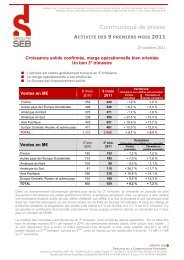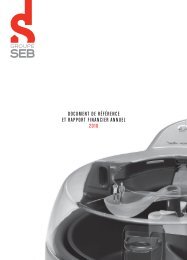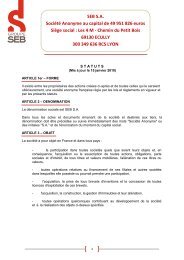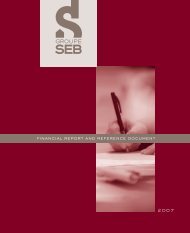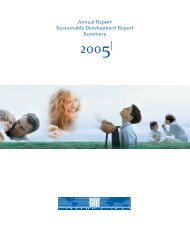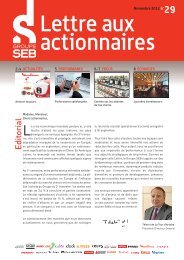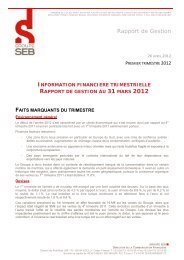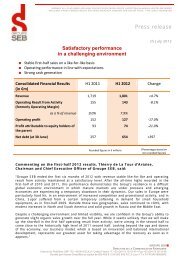financial report and registration document 2011 - Groupe SEB
financial report and registration document 2011 - Groupe SEB
financial report and registration document 2011 - Groupe SEB
You also want an ePaper? Increase the reach of your titles
YUMPU automatically turns print PDFs into web optimized ePapers that Google loves.
Derivative instruments designated as the hedging instrument in a hedging<br />
relationship may be classifi ed as either fair value or cash fl ow hedges:<br />
� a fair value hedge is a hedge of the exposure to changes in fair value of<br />
a recognised asset or liability or an unrecognised fi rm commitment that<br />
is attributable to a particular risk <strong>and</strong> could affect profi t;<br />
� a cash fl ow hedge is a hedge of the exposure to variability in cash fl ows<br />
that is attributable to a particular risk associated with a recognised asset<br />
or liability or a highly probable forecast transaction <strong>and</strong> could affect profi t.<br />
The gain or loss arising from remeasurement at fair value of derivative<br />
instruments designated as fair value hedges is recognised in profi t, offsetting<br />
all or part of the gain or loss recognised on the hedged item.<br />
In the case of cash fl ow hedges, the effective portion of the gain or loss<br />
arising from remeasurement of the derivative instrument at fair value is<br />
recognised in equity <strong>and</strong> the ineffective portion is recognised in profi t. The<br />
cumulative gains <strong>and</strong> losses on cash fl ow hedges recognised directly in<br />
equity are reclassifi ed into profi t when the hedged item affects profi t.<br />
Hedge accounting is applied when:<br />
� the hedging relationship is formally designated <strong>and</strong> <strong>document</strong>ed at the<br />
inception of the hedge;<br />
� the hedge is expected to be highly effective <strong>and</strong> is determined actually<br />
to have been highly effective throughout the fi nancial <strong>report</strong>ing periods<br />
for which it was designated.<br />
At the inception of each hedge, the hedging relationship is formally<br />
<strong>document</strong>ed, specifying in particular the Group’s risk management objective<br />
<strong>and</strong> strategy for undertaking the hedge. The initial <strong>document</strong>ation also<br />
includes details of how the Group will assess the hedging instrument’s<br />
effectiveness. In subsequent periods, the hedging instrument’s actual<br />
effectiveness in offsetting the exposure to changes in the hedged item’s fair<br />
value or cash fl ows attributable to the hedged risk is also fully <strong>document</strong>ed.<br />
Hedge accounting is discontinued prospectively when the derivative<br />
instrument ceases to be a highly effective hedge or when it expires or is<br />
sold, terminated or exercised.<br />
Changes in the fair value of derivative instruments that do not qualify for<br />
hedge accounting are recognised in profi t.<br />
1.4.5. Inventories<br />
Raw materials <strong>and</strong> goods purchased for resale are measured at purchase<br />
cost, using the weighted average cost method.<br />
Work-in-progress <strong>and</strong> fi nished products are measured at cost, including raw<br />
materials <strong>and</strong> labour <strong>and</strong> a portion of direct <strong>and</strong> indirect production costs.<br />
In accordance with IAS 2, inventories are measured at the lower of cost,<br />
determined as explained above, <strong>and</strong> net realisable value.<br />
Net realisable value corresponds to the estimated selling price in the ordinary<br />
course of business less the estimated costs necessary to make the sale<br />
(mainly distribution costs).<br />
The carrying amount of inventories does not include any borrowing costs.<br />
Financial Report <strong>and</strong> Registration Document <strong>2011</strong><br />
5<br />
Consolidated fi nancial statements<br />
Notes to the consolidated fi nancial statements<br />
1.4.6. Trade receivables<br />
Trade receivables are measured at the lower of their nominal amount – which<br />
approximates fair value due to their short maturity – <strong>and</strong> their estimated net<br />
realisable value. Provisions for impairment are determined on the basis of<br />
the age of the receivables, taking into account any identifi ed recovery risks.<br />
1.4.7. Cash <strong>and</strong> cash equivalents<br />
Cash <strong>and</strong> cash equivalents comprise cash at bank <strong>and</strong> on h<strong>and</strong> <strong>and</strong> shortterm<br />
investments in money market instruments. These instruments have<br />
maturities of less than three months; they are readily convertible into known<br />
amounts of cash <strong>and</strong> are subject to an insignifi cant risk of changes in value.<br />
The consolidated cash fl ow statement is presented using the indirect method<br />
<strong>and</strong> cash fl ows are analysed between operating, investing <strong>and</strong> fi nancing<br />
activities.<br />
IAS 7 was amended following the publication of IAS 27R. The aggregate cash<br />
fl ows arising from obtaining or losing control of a subsidiary are classifi ed<br />
as investing activities while cash fl ows arising from changes in ownership<br />
interests in a fully consolidated subsidiary are classified as financing<br />
activities. Transactions with jointly controlled entities or entities accounted<br />
for by the equity method continue to be classifi ed as investing activities.<br />
1.4.8. Treasury stock<br />
Treasury stock is deducted from equity at cost. Any gains or losses arising<br />
from the purchase, sale, issue or cancellation of treasury stock are recognised<br />
directly in equity without affecting profi t.<br />
1.4.9. Income taxes<br />
Income tax expense <strong>report</strong>ed in the income statement corresponds to current<br />
tax for the period <strong>and</strong> changes in deferred taxes.<br />
In accordance with IAS 12 – Income Taxes, deferred taxes are recognised for<br />
temporary differences between the carrying amounts of assets <strong>and</strong> liabilities<br />
<strong>and</strong> their tax base. They are determined using tax rates (<strong>and</strong> tax laws) that<br />
have been enacted or substantively enacted by the balance sheet date.<br />
Temporary differences include:<br />
a) taxable temporary differences, which are temporary differences that will<br />
result in taxable amounts in determining taxable profi t (tax loss) of future<br />
periods when the carrying amount of the asset or liability is recovered or<br />
settled; <strong>and</strong><br />
b) deductible temporary differences, which are temporary differences that<br />
will result in amounts that are deductible in determining taxable profi t (tax<br />
loss) of future periods when the carrying amount of the asset or liability<br />
is recovered or settled.<br />
GROUPE <strong>SEB</strong><br />
5<br />
87



